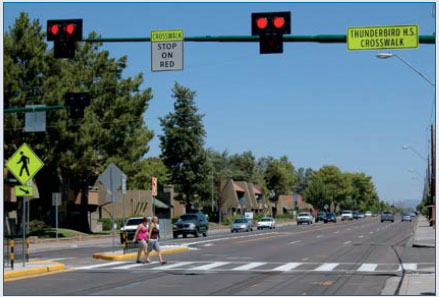TTAP Newsletter: RoadTalk
New FHWA Pedestrian Hybrid Beacon Guide Available
by Matt Cate, P.E.

The Federal Highway Administration (FHWA) has published a new Pedestrian Hybrid Beacon Guide. The pedestrian hybrid beacon (or PHB, also known as the HAWK signal) is a pedestrian-activated warning device located on the roadside or on mast arms over midblock pedestrian crossings. FHWA has designated the PHB as one of nine Proven Safety Countermeasures. The PHB joins median and pedestrian crossing islands and road diets on this list as a proven but underutilized tool to improve pedestrian safety. The guide provides users with information on the operation and safety benefits of PHBs, guidelines and recommendations for their use, and an in-depth case study of a PHB installed on Buford Highway in DeKalb County, Georgia.
PHB Background
The PHB is a traffic control device similar to a European pedestrian signal (PELICAN) that was imported to the US and adapted by engineers in Arizona to increase motorists’ awareness of pedestrian crossings at uncontrolled marked crosswalk locations. A PHB is distinct from pre-timed traffic signals and constant flash warning beacons because it is only activated by pedestrians when needed.
PHBs are becoming increasingly popular with State and local transportation agencies to fill the gap between unprotected crosswalks and full traffic signals to serve pedestrians. PHBs are useful in locations where traditional crosswalk signings and markings do not result in adequate motorist yielding rates, and where the deployment or cost of a full traffic signal would not be warranted. This includes mid-block crossings or uncontrolled mainline crossing points.
PHB Operation The design of the PHB consists of two horizontally-arranged red lenses above a single yellow lens. As shown below, the signal face for drivers remains unlit or “dark” until the pedestrian activates the system. While the signal is dark, the pedestrian display shows a Don’t Walk indication. To activate the PHB pedestrians push an accessible button located on a pole or post at the roadside. The actuated beacon then begins to flash yellow to warn motorists that the beacon has been activated. This brief flashing yellow interval is followed by a steady yellow interval, then by a steady red signal indicating motorists need to come to a complete stop and wait at the stop line. While motorists are seeing the steady red indication, the Walk sign is lit for pedestrians, allowing them to cross the roadway. After the pedestrian WALK phase ends, the pedestrian signal indication changes to a flashing DON’T WALK to notify pedestrians not to begin crossing. During the flashing Don’t Walk phase, the PHB displays alternating flashing red lights to drivers. The flashing red indicates to drivers that they are to stop and yield to pedestrians in the crosswalk, and can proceed once pedestrians are clear.
Safety Benefits of PHBs
PHBs can lead to lower conflict and crash rates for pedestrians and vehicles. FHWA’s evaluation of pedestrian PHBs found that their installation can reduce crashes. Pedestrian crashes were reduced by 69 percent. There was a 19 percent reduction in total crashes. The research also concluded that severe crashes were reduced, while rear-end collisions did not increase. The FHWA study also suggested that crashes categorized as “severe” could be reduced by 15 percent. In addition to improving safety for pedestrians, PHBs provide benefits to motorists as well: Compared to traditional signalized crossings, PHBs reduce delays at pedestrian crossings by 50 percent.

Photo Credit: Mike Cynecki
In most states (including Tennessee) it is illegal to pass a motorist who has stopped to yield to a pedestrian in a crosswalk. However, it may be unclear to following motorists if a car is stopped for a pedestrian or for some other reason. The first yielding motorist can obscure pedestrians from the following motorists, which can lead to pedestrians being hit by “second threat” motorists. The PHB addresses this potential problem by clearly indicating that the crosswalk is being used and that all motorists must come to a complete stop.
To learn more about the Pedestrian Hybrid Beacon, view the Pedestrian Hybrid Beacon Guide online at http://safety.fhwa.dot.gov/ped_bike/tools_solve/fhwasa14014/. To learn more about other options to improve pedestrian safety, visit FHWA’s Pedestrian & Bicycle Safety website at http://safety.fhwa.dot.gov/ped_bike/.
Back-Contents-Forward
